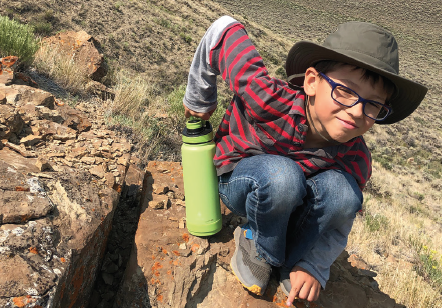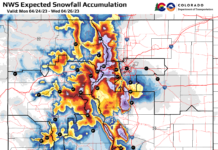by Marissa Lorenz
Grand County Library District patrons were treated to a guided tour of the Kremmling Cretaceous Ammonite Locality
this week as part of the GCLD’s ongoing summer programs.
Nearly two dozen explorers attended the event on Monday morning to be greeted by Bill Wyatt, Archeologist with the Bureau of Land Management Kremmling Field Office. Wyatt introduced participants to the site, telling them about the geologic history and the time when the area was submerged by a great inland sea, the Western Interior Seaway, which stretched from the Arctic Circle to the Gulf of Mexico some 100 million years ago, and which once covered the region of Kremmling with an estimated 300-500 feet of water.
The site, thought to have the largest concentration of giant ammonite fossils in the world, is theorized to have been a mating
site for ancient sea creatures.
Most of these would have been invertebrates, soft-bodied creatures protected by a hard outer shell, like the giant ammonites (Placenticeras meeki), whose shell could reach a diameter of 3 feet and whose long tentacles would trail behind them.
It is currently believed that the ammonites, possibly related to today’s squid and octopi, may have been “similar in behavior to today’s salmon,” returning to designated breeding areas every year, only for the adults to die after spawning and a new life-cycle to begin.
Most of the ammonite fossils themselves were taken prior to the site being designated a Research Natural Area in 1983. Some of them can be seen in museums, but most have disappeared into private collections. What remains visible on the surface of the sage-covered landscape are the sandstone casings that formed around the fossilizing creatures.
Collection of anything at the site is prohibited today, in order to prevent the unauthorized taking of fossils and artifacts from the area and to allow for organized scientific study. Wyatt says it is a good reminder that it is illegal to take any cultural artifacts-like arrowheads, nails, or tin cans-from any federal lands, but the collection of natural souvenirs is not permitted at the Kremmling Ammonite Site either.
In addition to the ammonites, hikers were encouraged to search for evidence of other ancient marine animals found at the site, including “over 100 species of mollusks, nautiloids, clams, and gastropods, and rare species of bryozoans (moss animals), brachiopods
(lamp shells), crabs and lobsters, vertebrates (fish and marine reptiles), and terrestrial plants.”
Josh Lebsock, who celebrates his 11th birthday this week, was among the adventurers along with his mom, Cheryl, and brother Isaac, 8. The boys are students at Stargate Elementary in Thornton, Colorado, and Grand Lake residents during the summer.
Josh asked Wyatt numerous questions about the animals, their skeletal structure, and their descendents, but said he was most looking forward to the after-lunch portion of the outing when the group would move to an area that is not protected and where he could “look for my own fossil.”
Invertebrate fossils (but not fish or dinosaur fossils) can be hunted and collected at nearby locations, but Wyatt urges thoughtfulness even there. He advised that participants hunt and pick, returning a fossil if a better one is found and only taking one for each person.
“That way, others can find something in the future.” Isaac was the first hiker to find evidence of serpulids, an ancient tube-building worm.
And Mom Cheryl raved about all of the Library District’s summer offerings. The family recently discovered Cataract Lake through the Library program and is already registered for each of the remaining expeditions.
“I’m so impressed with how the Library’s programs really make use of the area resources,” Cheryl Lebsock observed. “We were so excited when we were told a 4-wheel-drive vehicle was recommended, we needed to bring water, sunscreen, et cetera. You don’t get that in Denver area libraries.”
Chris Newell, GCLD’s new Director of Public Services was excited about the entire summer program, not just the Ammonite Site hike.
“It’s been a really successful year for the library,” Newell enthused.
“People are really excited to be back to programs in-person. They are ready to read new books and talk about books and get outside
to learn new things. We have definitely seen an increase in the summer numbers this year.”
For more information on the Grand County Library District’s calendar of nearly daily summer activities or to register for special events, go to https://gcldco.evanced.info/Signup.
For more about the Kremmling Cretaceous Ammonite Locality, go to https://www.blm.gov/office/kremmling-field-office or contact the Kremmling BLM Field Office at 970-724-3000.
The Ammonite Site is administered by the BLM and is open to the public year-round. It can be a somewhat rugged road access, and a short steep hike is required to reach the site.
Editor’s note - The Kremmling Cretaceous Ammonite site is a true jewel among the many adventures surrounding Kremmling. It is a 13-mile drive north of Kremmling - take County Road 25 and follow it for half a mile, at themY intersection turn left onto County Road 26., follow 26 for approximately 3 miles, at the bottom there will be a 2 track road on the left, follow that approximately one mile to the top of the ridge to the parking area with a gate and a check in box. To pick up literature, check road conditions and get additional information, visit the BLM office on Highway 40 in Kremmling or call 970-724-3000.








